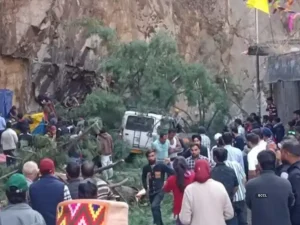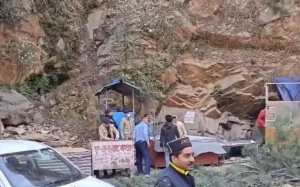Himachal Pradesh – A landslide near a prominent religious site in Himachal Pradesh’s Kullu district resulted in the tragic loss of six lives and injuries to several others in the Manikaran Gurudwara Landslide. The Manikaran Gurudwara Landslide, triggered by heavy rainfall, occurred when a massive tree, loosened by shifting soil, collapsed onto vehicles parked near the location. The area had been previously cleared of illegal encroachments, but concerns remain regarding unauthorized commercial activities resuming in the region.
Manikaran Gurudwara Landslide Overview

The landslide struck in the evening, around 5 PM, following a period of intense rainfall. A massive deodar tree, positioned on a mountainside opposite the religious site, was uprooted due to the unstable ground conditions. The tree fell onto multiple vehicles parked along the road, leading to immediate casualties and critical injuries.
Emergency response teams, including local authorities, disaster management personnel, and medical teams, quickly arrived at the scene. Their immediate priority was to rescue survivors, provide medical attention to the injured, and remove debris from the affected area. Several individuals were extricated from the wreckage and transported to nearby medical facilities for urgent care.
Victims and Injuries in the Manikaran Gurudwara Landslide
The Manikaran Gurudwara Landslide claimed six lives, while three others suffered injuries. Among the deceased were individuals visiting from different regions, as well as locals residing in the area. Some victims were tourists who had come to visit the religious site. Authorities are working on confirming the identities of all deceased individuals and have reached out to their families.

Injured survivors of the Manikaran Gurudwara Landslide were swiftly transported to local hospitals, where they are receiving treatment. Medical personnel have stated that while some injuries are minor, others remain critical, requiring extensive medical intervention. The administration has assured that all necessary medical aid will be provided to the victims and their families.
Official Statements
A local administrative official confirmed the sequence of events, stating that the Manikaran Gurudwara Landslide caused the deodar tree to collapse onto the road, leading to severe destruction. The official also noted that multiple vehicles were damaged in the process, further complicating rescue efforts.
Authorities have launched an investigation into the factors contributing to the landslide. The initial assessment suggests that prolonged heavy rainfall loosened the soil, destabilizing the tree’s roots and leading to the collapse. Further studies will be conducted to determine additional causes and preventive measures that can be implemented in the future.
Previous Encroachment Clearance
The area where the Manikaran Gurudwara Landslide occurred had previously been subject to illegal encroachments. Unauthorized stalls and shops had been set up along the roadside, contributing to congestion and potential safety risks. Authorities had conducted clearance operations in the past, aiming to mitigate such hazards.


Despite the removal of illegal structures, reports suggest that some vendors had resumed their businesses in the cleared area. The Manikaran Gurudwara Landslide raises concerns about the enforcement of regulations and the necessity for stricter monitoring to prevent encroachments from reoccurring.
An official from the disaster management team emphasized the importance of maintaining clear zones in landslide-prone areas. He stated that encroachments can obstruct natural drainage systems, exacerbate soil erosion, and increase the risk of such disasters. A comprehensive report is being prepared to assess the impact of previous clearance efforts and propose long-term solutions to prevent further incidents.
Response from Authorities
Following the Manikaran Gurudwara Landslide, government officials have announced plans to reinforce monitoring in the region. Authorities are evaluating current safety protocols and considering additional measures, such as restricting vehicle parking in vulnerable zones and installing barriers to prevent further encroachments.
Teams from disaster management agencies have been deployed to survey the affected area and identify potential hazards that may require immediate attention. Preliminary reports indicate that soil erosion and water saturation from continuous rainfall played a significant role in triggering the landslide.
Officials have urged residents and visitors to exercise caution, especially during the monsoon season when the likelihood of landslides is significantly higher. Warning signs and advisories will be issued to ensure the public remains informed about the risks associated with unstable terrain.
Environmental and Structural Factors
The region where the landslide occurred is known for its rugged terrain and susceptibility to natural disasters. Landslides in the area are often caused by a combination of heavy rainfall, deforestation, and unregulated construction. Experts have pointed out that deforestation weakens the soil’s ability to retain moisture, increasing the likelihood of landslides.
Additionally, haphazard urbanization and road construction have disrupted the natural balance of the land. Roads built without adequate reinforcement in landslide-prone areas can accelerate soil erosion and destabilize slopes. Environmentalists have stressed the need for sustainable infrastructure planning that prioritizes long-term safety over short-term development.
Safety Measures and Future Precautions
In response to the Manikaran Gurudwara Landslide, authorities have outlined a series of safety measures aimed at preventing similar incidents in the future. These include:
- Strict Monitoring of Encroachments: Regular inspections will be conducted to prevent unauthorized stalls and structures from reappearing in cleared zones.
- Improved Drainage Systems: Enhancing drainage channels to prevent water accumulation and soil erosion.
- Landslide Risk Assessments: Conducting geological surveys to identify high-risk areas and implementing protective measures.
- Public Awareness Campaigns: Educating locals and tourists about the risks associated with landslides and necessary precautions.
- Enhanced Emergency Response Protocols: Strengthening disaster response mechanisms to ensure rapid action during emergencies.
Authorities have emphasized that while some disasters are unavoidable, preparedness and preventive measures can significantly reduce casualties and damage.
Community Reactions to the Manikaran Gurudwara Landslide
The tragic event has deeply affected the local community and visitors alike. Residents have expressed their condolences to the families of the victims while also voicing concerns about the recurring nature of such incidents in the region. Some have called for better urban planning and stricter enforcement of environmental regulations to ensure long-term safety.
Community members have also stepped forward to assist with relief efforts. Volunteers have been working alongside officials to clear debris, provide aid to affected families, and offer support to survivors. Religious institutions in the region have opened their doors to provide shelter and assistance to those in need.
Also Read: Woman’s Decomposed Body Found in Bed Box: Shocking Crime in Delhi
Calls for Policy Changes
In light of Manikaran Gurudwara Landslide, policymakers and environmentalists are urging the government to implement more stringent regulations to prevent further loss of life due to landslides. Proposals include stricter building codes, afforestation programs to strengthen soil retention, and relocation of vulnerable communities to safer zones.
Experts stress that addressing the root causes of landslides requires a multi-faceted approach. Combining scientific research, responsible urban planning, and community engagement can lead to more effective disaster mitigation strategies.
Closing Statements
The landslide near the religious site in Himachal Pradesh serves as a stark reminder of the dangers posed by natural disasters, especially in ecologically fragile areas. While immediate response efforts have helped mitigate the impact, long-term solutions must be prioritized to prevent such incidents in the future.
Authorities must enforce strict regulations against encroachments, improve land management practices, and invest in sustainable infrastructure to safeguard lives and property. Increased awareness and community participation will also play a crucial role in ensuring that such tragedies are minimized in the years to come.
As investigations continue, the focus remains on providing support to the victims and implementing necessary measures to enhance disaster preparedness in the region. Through coordinated efforts and proactive planning, future risks can be reduced, making the region safer for both residents and visitors.

